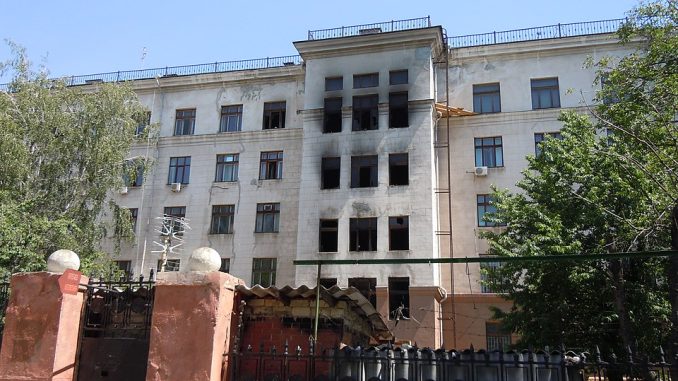Peloni: How ironic is it that Ukrainians were forced to wait ten years before even this much justice was provided for the savagery which took place on May 2, 2014 during the Odessa Massacre. Having spiraled first into a Civil War and followed by a war with Russia, much could have been avoided had justice rather than division been the hallmark of the aftermath of the 2014 US sponsored coup. The lives of hundreds of thousands of Ukrainians/Russians, and the devastation across Ukraine might all have been prevented, had only the govt which claimed to be acting on behalf of the Ukrainian people embodied this claim by pursuing even the most basic level of justice which even the anti-Russian ECHR has now provided, over a decade later. But then again, justice for the Ukrainian people has never been the interest of the Ukrainian govt.
Christine Yang | U. Ottawa Faculty of Law, CA |
 By The image created by © Yuriy Kvach, CC BY-SA 3.0
By The image created by © Yuriy Kvach, CC BY-SA 3.0
The European Court of Human Rights (ECHR) ruled on Thursday that Ukraine violated the European Convention on Human Rights by failing to prevent and investigate violence during the Odesa’s pro-European Maidan protests in 2014.
In late April 2014, Ukrainian authorities obtained intelligence showing signs of possible incitement to violence and mass riots at the “For a United Ukraine” rally in Odesa on May 2, 2014. However, on the rally day, limited police forces were deployed to the city center and the stadium. Video footage from the protest showed inaction by the police when pro-Russian activists and Maidan supporters were firing numerous shots, throwing stones and Molotov cocktails at each other. Despite numerous calls to the fire brigade, the fire service was not deployed to the scene until later in the evening when a fire broke out in the Trade Union Building, claiming 42 lives.
Between June 2017 and October 2018, 28 people filed applications to the ECHR, claiming that the state had failed to protect their lives and those of their relatives and that there had been no effective domestic investigation into the matter. As a result, the applicants argued the state violated Article 2 (right to life), Article 3 (prohibition of inhumane or degrading treatment) and Article 13 (right to an effective remedy) of the Convention.
A unanimous court held that Ukrainian authorities violated the applicants’ right to life when they failed to do everything that could reasonably be expected of them to prevent the violence, to stop the violence after its outbreak, to ensure the timely rescue of people trapped by fire, and to conduct an effective investigation into the events.
The court noted that the Ukrainian authorities had a basic duty to use reasonable means to avert the risk of violence. This includes having regulatory and administrative frameworks in place to deter violence and providing appropriate and functional measures to ensure public safety. While certain preventive measures had apparently been taken, the court found they had not been provided with sufficient information to assess them.
Furthermore, the court also found that the authorities had not made enough effort to properly secure, collect and assess all the evidence after the event, nor was the investigation openly and promptly pursued within a reasonable timeframe. While there was extensive photographic and video evidence regarding the clashes from the rally and the fire at the Trade Union Building, the court again was not provided with enough details as to how the investigation authorities dealt with the evidence and whether they had made genuine efforts to identify all the perpetrators.
The court ordered the Ukrainian authorities to pay the applicants varying amounts of non-pecuniary damages, costs and expenses pursuant to Article 41 of the Convention.



@fquigley
I am not sure why you are surprised. This court is aligned with Ukraine. If you read the entire report, which I have, you will know that they refused to even consider many of the issues which arose surrounding the massacre of May 2, 2014. The idea that they would relate their limited judgement to anything so relevant as the Nazi contingent roaming the streets or involved in the govt. They simply provided a unanimous judgement of the culpability of Ukraine’s govt in failing to prevent the slaughter from taking place as well as their active failing in subsequently investigating the tragedy. Even the limit of this ruling, however, should be understood to be a meaningful victory.
Peloni
I was a little surprised at your reply to me
“Of course not. This was the anti-Russian ECHR.”
To my comment linking the Odessa murders by fire of Russian speaking and sympathising also…to the Pogroms of Jews (many by fire also) in as far back as the massive Pogroms of 1918 to 1921
@fquigley
Of course not. This was the anti-Russian ECHR. What they did state, however, was significant, and their obvious bias only reinforces the significance of their unanimous ruling in finding against their Ukrainian allies, to the limit that they did find against them.
Does not mention, I think, it was led by Ukrainian Bandera Neonazis with a history going back to the 1918 to 1921 Pogroms of Jews. Thus this Court is engaged with a sophisticated whitewash.